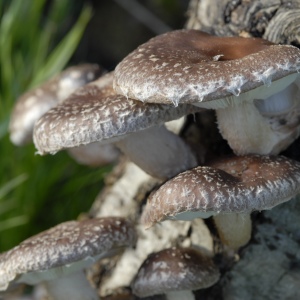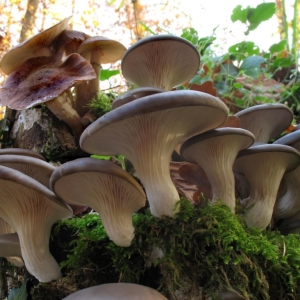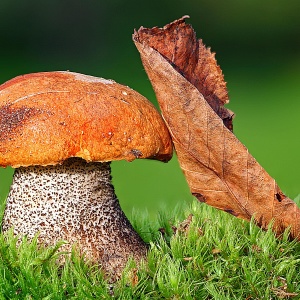Weighs that grow in wildlife, much more fragrant and tastier those that are grown in special fungal farms. But in order not to harm your health and health of loved ones, forest oysters need to be distinguished from other similar fungi. The latter may be unsestable.
How rash in the woods are growing - the classification of mushrooms
There are five species of wild oyster. All of them belong to the so-called conditional and edible mushrooms. This designation suggests that with insufficient culinary processing, mushrooms can be poisoned. In the forest you can meet such oysteries:
- Ordinary. The second name is oyster.
- Abundant. The second name is Rozhkovoid.
- Pulmonary.
- Late. The second name is autumn.
- Orange.
They differ from each other with the shape and size of the caps, color and duration. All species grow large colonies on the trunks of the fallen or standing, but dried trees. Also, old dummy stumps or cleaners can also be settled, duly falling asleep with dead crust.

How grieves grow in the forest - an ordinary oyster
- Ordinary oyster is found in the forest most often. It grows on the trunks of the trees with large stepped groups, the simultaneous total weight of which can reach 3 kilograms.
- The size of the hats in diameter can reach 17-18 cm.
- The shape of the hats is mainly rounded with falling edges, i.e. A little curved down.
- In addition to rounded, the hats can be in the form of a language - a bit of an extended form.
- The top of the hats is concave and convex.
- The color of ordinary oyster can be completely different, ranging from light gray (almost white) to a very dark gray-violet.
- The legs have an ordinary oyster if they grow on horizontally lying trees, quite long and are closer to the side of the hat.
- On the vertical trees of mushrooms are attached to the trunk using shorter legs.
- Fruit is common from the beginning of summer and to the most frosts. At the same time, a small frost of mushrooms do not harm at all and they do not lose their taste properties.
- Oyster's oyster is almost never damaged by worms.

How rising oysteries in the forest - an abundant oyster
Oyshemka is abundant in deciduous forests since May and to the autumn itself. At the same time, if the frosts are coming, then the mushrooms look no sense - they freeze. Mass herbal oysters abundant fruit at the beginning of summer and at the end of the autumn - they are very loved by moisture, which at this time because of the rains there are quite a lot. Mushrooms grow mainly on old rowan, birch, oaks and knitters. The color of the hats at abundant peel varies from light cream to brown-golden. The maximum size of the hat is 10-12 cm. It is possible to distinguish an oyster. Abundant from other species can be on the wavy edge of the hat and a torrential smell. The long curved leg to the hat is attached in these mushrooms almost in the center. At the very bottom on the leg, you can see a drawing that resembles bee honeycomb cells. Oyster's oyster is strongly amazed by worms, especially if she is old.

How grieves in the forest are growing - pulmonary oyster
Pulmonary oyster grows on aspins, beats, oaks and birch. From other species, it is distinguished by almost white - because of this it is very difficult to confuse with other mushrooms. Hats - convex, with a thin edge lowered down. The leg with a delicate edge resembling velvet. Despite its delicate look, the oyster is pulmonary tolerating well and can be stored in a cold without loss of appearance up to 3-4 days. Mushrooms are practically not damaged by the worms and are best shot in individual country farms. Having gathered a pulmonary oyster in the forest, it can be decomposed near the stumps in the yard and expect a homemade harvest.

How griends grow in the forest - late
Oyshemka Late or Autumnally justifies its name. It is possible to collect it only in October-November, when it starts fruit. The mushroom is growing mainly on coniferous trees, but occasionally find it on deciduous. From other species, this weighing is distinguished by a greenish color, resembling the color of olives. Abundant colonies consist of mushrooms with 3-10 cm diameter hats and short thick legs. To the touch, the caps are very soft, as if velvet, but with strong moisture become very smallest. The legs of autumn oyster have the same greenish color, sometimes cast yellow. Yellow in these mushrooms and the lower part of the hats, which consists of tightly adjacent narrow plates. Autumn's mushroom is not very popular with mushrooms, because her pulp has a strong bitter taste.

How rash in the forest is growing - Orange orange
Orange messenger fully justifies its name - it has a very juicy and bright color. The legs have practically no legs and it is attached to the tree trunk using a hat. This mushroom has a rather strange smell. Young specimens smell melon, and old - rotten cabbage. Orange orange is found in the forest very rarely, but the craftsmen of mushrooms practically does not care. Many people consider it not even a conditionally edible mushroom, but in general inedless. Although with long-term boiling in several waters of mushrooms, harmful substances leave and you can eat. Recently, spores of orange orange can be bought in garden stores - they are sacred on the stumps landscape designers and thus adorn privately furnished.

It is better to use the smallest copies of any oysteries - they have a very gentle taste. The greatest hats are very coarse and are not distinguished by a bright mushroom taste.






























